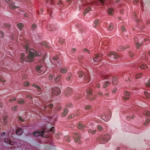Dr. Appenzeller also discussed a new clinical guideline from the nonprofit KDIGO (Kidney Disease Improving Global Outcomes). KDIGO recommends clinicians follow up abnormal urinalysis findings of proteinuria or urine sediment and proceed with biopsy if quantified proteinuria is greater than 0.5 g/day, or glomerular filtration rates are decreasing.6 For context, a 2012 clinical guideline from the ACR recommended kidney biopsy in patients with proteinuria >1.0 g/day or with proteinuria >0.5 g/day accompanied by hematuria or cellular casts.7 (Note: An updated ACR guideline on lupus nephritis is expected in 2025.)
Many clinicians opt not to perform a kidney biopsy if proteinuria doesn’t fall above a certain level. However, Dr. Appenzeller shared results from a cross-sectional study of 222 patients demonstrating that some important kidney pathology could be seen via histology in patients with lupus who had active urine sediment but low levels of proteinuria (<0.5 g/day). Thus, she recommended considering kidney biopsy even in patients with low-grade proteinuria.8
Histological Patterns
Lupus is a notoriously heterogenous disease, and lupus nephritis displays varying histological patterns as classified by the International Society of Nephrology/Renal Pathology Society (ISN/RPS). Patients with class I (minimal mesangial) and class II (mesangial proliferative) lupus nephritis typically have mild or absent clinical features. Patients with class III (focal disease) and class IV (diffuse disease) lupus nephritis have comparatively more acute injury, hematuria, proteinuria and chronic disease. Patients with class V (membranous disease) lupus nephritis have the highest rate of nephrotic syndrome, and class VI represents rare and advanced sclerosing disease.9
Dr. Appenzeller shared that biopsy patterns can also give clinicians helpful prognostic information. For example, a retrospective study of 382 patients with childhood lupus of class III or higher showed that patients with class III disease achieved complete remission more often than those with class IV or V disease.4
This same study highlighted the room for improvement in remission rates for childhood lupus: At 24-month follow-up, 57% of patients had achieved complete remission and 34% had achieved partial remission. Patients with severe disease at diagnosis had the highest risk of not achieving remission.4
Maintenance Therapy
Kidney biopsy can also enrich our understanding of true disease activity. For many years, researchers assumed that a complete clinical remission in lupus nephritis would be reflected in histological remission. But several studies have demonstrated this is not the case. Histologic findings may reveal ongoing inflammation not yet clinically apparent.10

